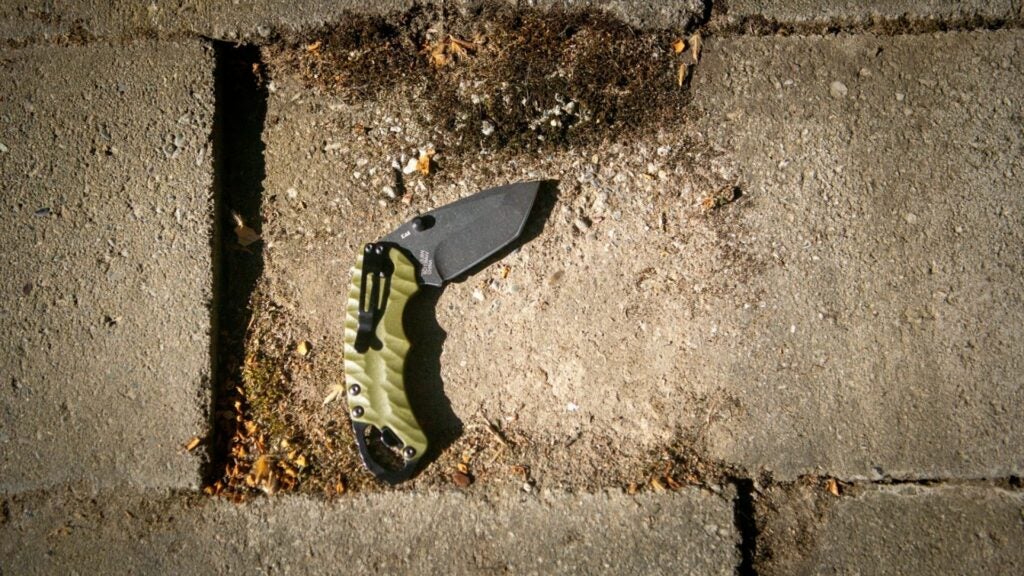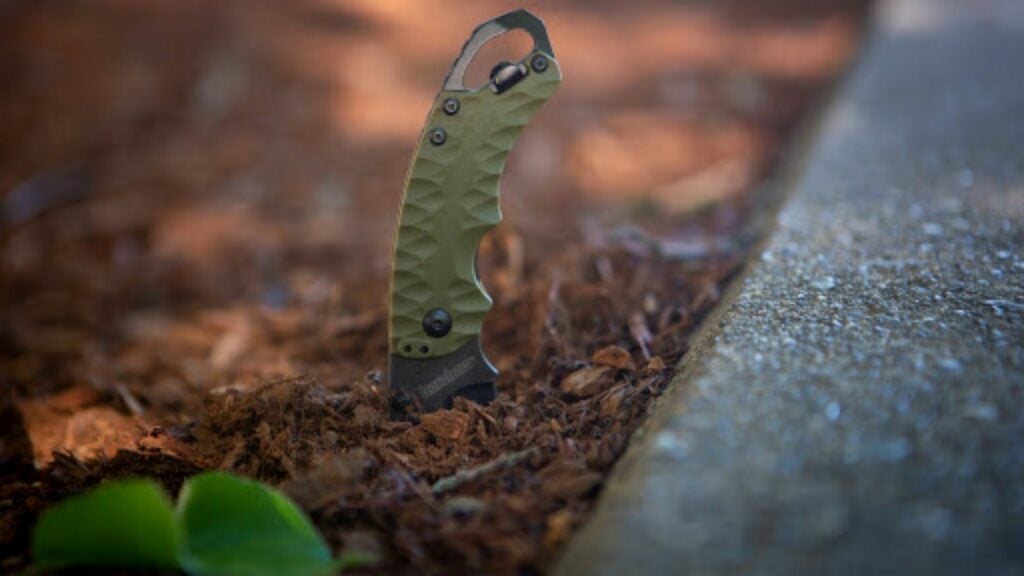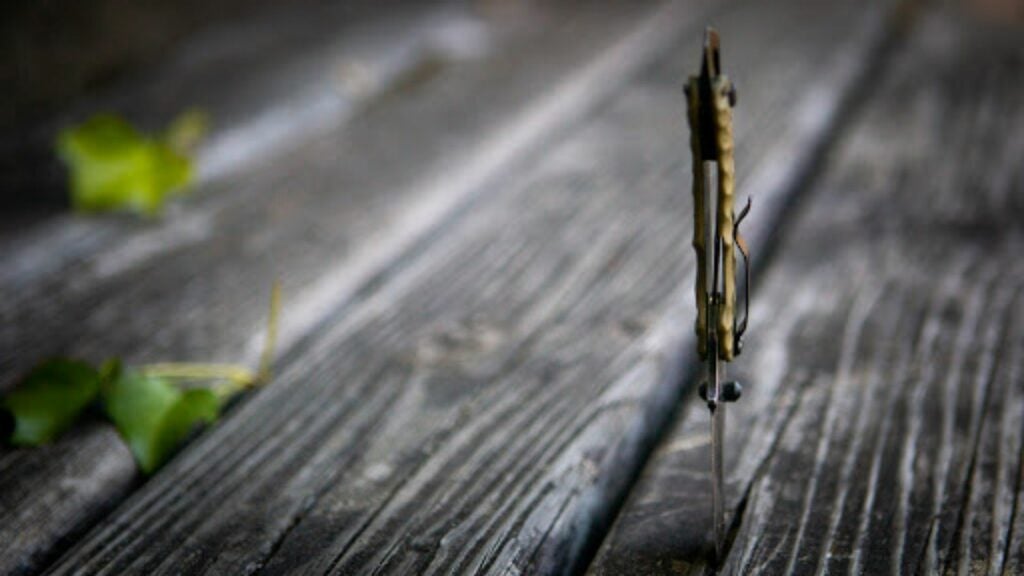My favorite knives have fixed blades (looking at you, Mora), but that leaves out a lot of choices. Let’s face it: a knife is only useful or practical if it’s on you when you need it, and something like the Mora isn’t going to cut it in an office setting or even a unit standup. Fixed knives are nearly always better than folding knives, but they aren’t appropriate to carry most of the time. Folding knives take care of visibility problems and generally aren’t as intimidating to your cubicle mate or those “combat” finance people working on your travel voucher.
While I did unspeakable things to knives as a loadmaster on C-17s and in force protection as an airman, it doesn’t seem right to baton a small folder like the Kershaw Shuffle II or throw it at anything. The Kershaw shuffled its way past some of my other abusive tests by having built-in features for opening bottles and driving slotted fasteners. I’m definitely in a cubicle these days and I don’t get to carry large fixed-blade knives. Because I go through security several times each day, I can’t even keep one in my briefcase. I can, however, keep a small pocket knife around, and they come in handy frequently for slicing open packages or breaking down cardboard boxes.
The Kershaw Shuffle II is great for doing that: opening packages and stabbing cardboard. That said, I’m not sure who this knife is for or why it exists. It’s not a bad knife, it just has some confusing properties that seem contradictory.
Blade length: 2.25 in
Weight: 3 oz
Materials: 8Cr14MoV stainless steel (blade), glassed filled nylon (handle)
Unboxing
I like Kershaw’s packaging. The Shuffle II came in a little red-orange box and shipped with a manual. Yes, a manual. For a folding knife. And frustratingly, the manual didn’t explain all of the features of the knife, like the not-quite-intuitive ambidextrous bottle opener or how the clip can be mounted on either side of the knife (more on that later). Overall, it’s unconventional, but it looks useful and I like it.
The knife itself comes in three colors, and mine is good old OD green. I was having trouble placing the aesthetics of the scales but eventually it hit me. The scales of the Kershaw Shuffle II are molded out of glass-filled nylon to look like G10 or Micarta with cut grooves for a 550-cord wrap. Sit back a bit and think about that. Remember that the Kershaw Shuffle II is a folding knife. I’ll wait. Design contradiction number one.

The only decoration on the scales is an embossed “CHINA” on the clip side. There’s an all-metal lanyard or keychain loop on the butt-end of the closed knife that ends in a flathead screwdriver. Looking at it, it seems perfect for dzus fasteners, scope or RDS adjustment, or the battery compartment screws on gear like night-vision goggles or active earpro. Then there are two little tabs on either side of the keychain loop that turn the loop into a bottle opener, another really handy feature. The last two external parts are a pocket clip and a two-sided thumb stud for easy one-handed opening. Closed, the knife is 4 inches long, which is about right for a pocket knife.
Opening the Shuffle II rewards you with a view of the 2.25-inch tanto point blade and the worn-in dark oxide coating that Kershaw calls “BlackWash.” I’m a fan of the BlackWash finish. I love sandblasted or tumbled blades and the dark color on a tumbled blade works well here. Opened up, the Shuffle II is a hair over 6 ¼ inches long. The blade has a liner lock and a spring-loaded ball and cup closing keeper.

How we tested the Kershaw Shuffle II
Despite the Kershaw Shuffle II’s small size, it seemed sturdy enough to test hard. I had a bonfire to start and some kindling to make. We had a wax log and a torch handy, but I’m stubborn and wanted to do it the hard way to get a good impression of this little knife.
Part of the reason the knife is so sturdy is the tanto-style blade. The tanto was invented by feudal warlords in Japan to puncture samurai armor. This style puts a lot more meat at the tip of the blade compared to a drop point, but tantos have drawbacks too. Tantos are exceptionally good for stabbing, but don’t slice particularly well because of the sharp angle in the belly of the blade. The angle creates two separate sections where a drop point blade would have a gentle curve and a continuous blade. Any design choices between the two are a trade-off between good slicing performance and good stabbing performance.
I started by splitting out some smaller pieces from good dry firewood until I had a fistful of straw-sized sticks. I used this exercise to test blade strength, sharpness, repeatability, and grip comfort. Because the tanto blade doesn’t slice particularly well, testing the Kershaw Shuffle II’s sharpness needed a long, straight stroke. The knife performed well here, but it was around this point I noticed I was starting to get a blister at the base of my index finger. I had been using the knife for about two minutes. The pocket clip was digging in and pinching my finger as I cut.
When faced with knife-based adversity, I take the same approach as I used to with enemy combatants or reticent airmen as an NCO: these colors don’t run, and I don’t negotiate with terrorists. I forged ahead after a grip adjustment and tested fine control of the blade by making a feather stick. By the time I was done, I was thirsty and found a great opportunity to test the bottle opener on the cap of a Topo Chico on my way to a Whiskey Collins.

I made my first mistake around this time. Well-lubricated with 100-proof rye and annoyed at my blister, I bragged about a one match fire. I carefully set up my kindling and smaller sticks with an assortment of other sticks and firewood arranged by size at arm’s length. I lit my kindling and it went up as expected, but when I put my larger feathered stick on, the feathers burned off and the log extinguished itself. No surrender, no defeat!
Cursing, I pulled the Shuffle II out and made twice the kindling with it. I made another perfect little pyramid of straw-sized sticks with a puff of dried grass and heartwood shavings under it, but set a second pyramid of full-sized firewood over the starter this time instead of trying to feed a log in. It lit right up and this time kept going. I mumbled something about it being take two of my single match fire, but deep down, we all knew it was a two-match fire and I was a failure.
The final test was as unsurprising as it was uninteresting. I needed to remove the tripod plate from a camera, and while I normally use a quarter for the flathead screw, I had the Kershaw Shuffle II handy. It worked well as a large screwdriver, to nobody’s surprise.
What we like about the Kershaw Shuffle II
The Kershaw Shuffle II is an interesting little knife. It’s compact and manages two useful features out of non-moving parts. The bottle opener is functional, if weird, and the screwdriver is basically a hidden treasure. You wouldn’t know either of those existed by just looking at the knife if someone else was using it. They become apparent after touching the Shuffle II for yourself. I love that. It feels like a spy’s tool in that regard.
I also like the finish on the blade. Kershaw got their BlackWash finish really right here, and it works both on its own and as part of the whole knife. I like how when it’s closed the Shuffle II is just a small non-descript oval.
When open, the knife feels solidly made and plenty sturdy. It’s decently sharp and has a wicked point to it. The thumb studs work exactly like they should and you can open the knife with one hand even if you’re a lefty (I’m assuming, because I’m a righty).
For me, a pocket knife should always have one-handed opening as a baseline feature. Think about it, you’re probably already holding something in your hands, and you just dug through your pocket or ruck with your free hand. Why would you want to set something down when it’s already in your hand? Kershaw hits the mark here.

What we don’t like about the Kershaw Shuffle II
The design contradictions are puzzling for me. I’m not sure who Kershaw made the Shuffle II for, but it wasn’t made for me. It’s small but has a design-heavy grip section with scalloping for fingers and a blade-integral finger guard. That’s in keeping with the tanto blade, which are made for stabbing specifically. What are you going to stab with a 2-inch blade though? You’re certainly not going to be piercing armor with this knife.
Doing finger cutouts on a knife this small seems pointless. Cutouts remove grip area without adding anything but looks. They’re really not necessary on a knife this size. Cutouts aren’t my only gripe. The size of the grip, the comfort of the grip, and the overall size of the knife are also problems. No one is going to do much stabbing with this knife except office supplies. It’s great for stabbing cardboard and breaking down recycling, but doesn’t seem useful in the “EDC” jack-of-all-trades way that it’s marketed for.
What I want in a pocket knife is a comfortable handle, small size, a blade with maximum utility, corrosion resistance, and a strong locking mechanism. While I see how some people would love the Kershaw Shuffle II, it’s not for me. The grip doesn’t make much sense. It’s a folding knife and yet looks like it’s meant to be wrapped in 550 cord.
The blade doesn’t make sense either. It’s a stabbing-specific shape which is so short at 2.6 inches that the forward perpendicular edge makes up nearly half of the blade length. The slicing edge is only an inch and change. Pocket knives are for slicing and cutting, not for armor piercing, and this knife doesn’t really slice. What’s the purpose of the tanto point other than looks? I’m definitely a form follows function kind of guy, and this knife wasn’t designed for me.
I have two more gripes, one minor, one not so minor. The first is that the knife has a liner lock. There’s nothing wrong with a well-designed liner or frame lock, I just don’t like them. I prefer lock backs and mechanical (button, lever, or switch) locks. I didn’t have any trouble with this liner lock slipping or bending, but I didn’t like that the lock is dead level with the liner and hard to get at if your nails are trimmed. I’d expect some knurling or serrations on the release and a little bit of extension so that it works well in the wet and cold. If this is an EDC knife, it’s likely to be the only knife on you, and it needs to work in every season.
My last gripe is the most serious. I don’t like the grip. It’s too small, has weird angles to it (almost karambit like), is pokey in the wrong places, and that damn pocket clip falls into exactly the wrong place on my hand. Keep in mind that I’m particular and have monster hands. The closed knife is smaller than my palm, and I don’t think that’s going to be a problem for everyone.
Verdict
While the Kershaw Shuffle II looks interesting at first glance, it winds up getting in its own way. For $20, it’s worth trying if you have smaller hands and work with a lot of cardboard boxes. Otherwise, it’s too small for my hands and has an uncomfortable grip. The tanto point is plenty strong, but doesn’t have much utility when it comes to the pocketknife’s cutting and slicing tasks. There isn’t enough of a guard for real stabbing duty and the blade isn’t long enough to do serious damage. The breaking point for me is the blister after only a few minutes of use. With 90 percent of the world being right-handed, why would it ship from the factory with the clip set up for lefties? It’s clearly swappable, and yet here we are.
Kershaw is known for excellent knives and I like a bunch of their current range as serious tools. This isn’t one of them. It’s more akin to a stocking stuffer or an add-on gift than something you’d want to get for its intended purpose. I was sad to write this review because I genuinely like how sturdy the knife is, that it has an unobtrusive bottle opener, and how it has a built-in dzus fastener tool. It stayed sharp through testing too, which impressed me for something so small and inexpensive. The facts are simple though: It’s a pocket knife, and as a pocket knife it’s not as useful as some other products out there.
A FAQ about the Kershaw Shuffle II
More questions? Here’s Task & Purpose’s additional brief.
Q. How much does the Kershaw Shuffle II cost?
A. The Kershaw Shuffle II is about $20 shipped depending on where you are.
Q. Do Kershaw knives have a warranty?
A. Yes, Kershaw offers a limited lifetime warranty on all of their knives. They’ll even sharpen your Kershaw blade for free if you send it to them.
Q. How long is the blade of the Kershaw Shuffle II?
A. The blade itself is only 2.25 inches. When the Kershaw Shuffle II is closed, it’s about 4 inches long, and when open, the whole knife is 6.3 inches long.
Q. Where is the Kershaw Shuffle II made?
A. The Kershaw Shuffle II was designed in the U.S. but manufactured in China. Kershaw still makes plenty of knives in the U.S., check here for a current list.
We’re here to be expert operators in everything How-To related. Use us, compliment us, tell us we’ve gone full FUBAR. Comment below and let’s talk! You can also shout at us on Twitter or Instagram.
Task & Purpose and its partners may earn a commission if you purchase a product through one of our links.
